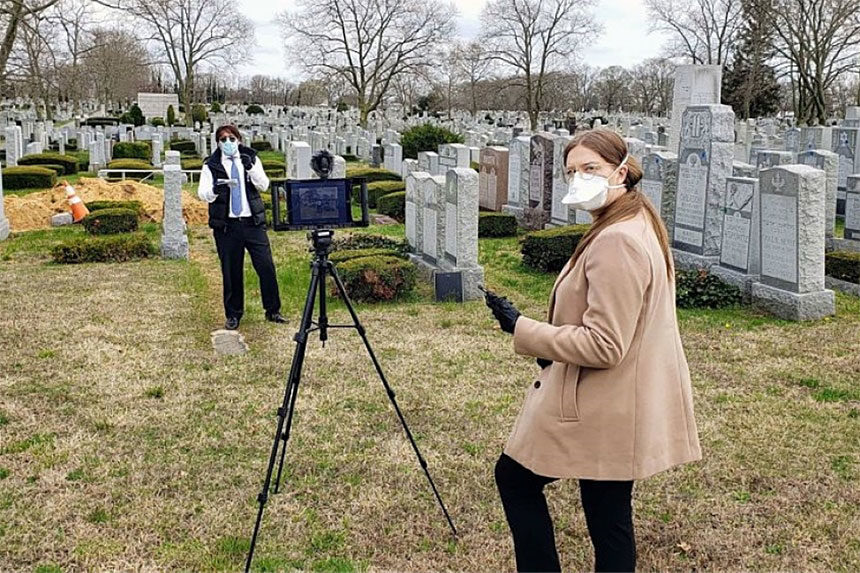On a chilly and rainy day in late April, I stood at a grave in Queens County, New York, with three mourners in protective masks, preparing to lead the graveside prayers. The casket had already been lowered, unlike how it has always been done, and it hit me that I would be praying to a hole.
The family members, who had come from Long Island to bury a 97-year-old grandmother, seemed to come to the same realization. They peered down uncomfortably into the grave, at the steel vault that covered the casket. There had been no church service or wake. And, now, they could not even be close to the casket that held their loved one’s remains.
I felt responsible, as if I were the one letting them down. But my discomfort at being unable to serve people properly was a fleeting bad moment in three draining months that have taken their toll on people like me who make their living as funeral directors. The deaths keep coming. And we keep doing our jobs. Unlike our fellow citizens, who can look away and find escape in not confronting the reality, we cannot.
As I spoke to other funeral directors in New York about what they have been going through, the same themes emerged time and time again: trying to cope as the wave of death overwhelmed us, finding a renewed sense of duty to the dead as families were kept away, fighting impossible odds to keep bodies from going unattended or shipped off to a potter’s field.
In the months preceding the U.S. outbreak, we all had watched the news of the pandemic as it played out in China and Italy. We were curious about how these countries were dealing with their dead. Perhaps it was a mix of wishful thinking and naivete that made us think, “That could never happen here.” Until it did, thrusting us into death overload by early April.
Funeral homes in the five boroughs of New York quickly became filled to capacity. As the pandemic gripped the city, the death toll in New York City reached almost 20,000 and funeral homes were forced to turn away scores of frantic families looking to bury their dead. They had neither the staff, nor capacity, to handle the surge of deaths. The city was prepared to send remains to New York City’s own potter’s field, on an island in the East River. The city order was later rescinded, but it only fueled our ever-present sense of urgency.
We all came to share grim accounts of what death had become in New York.
In Brooklyn, as a funeral home van made its way down a city street, residents called out to the driver from the sidewalks. “People were trying to flag it down because they have dead bodies in the house and the medical examiner’s not answering the phone,” Tom Libraro wrote on his Facebook page. “It just showed the desperation of people when the morgue attendants couldn’t handle it,” said Libraro, who works at Brooklyn Funeral Home & Cremation Service.
Anthony Cassieri, who owns Brooklyn Funeral Home & Cremation Service, usually handles about 450 funerals in a year. In the past month alone he has done 149.
“We couldn’t get the bodies embalmed fast enough for the people who were having viewings. There was no outlet for crematories. And we didn’t have the space to keep people.
“I had to close down for ten days to regroup,” says Cassieri. He didn’t want to be rendered as little more than a “body disposer.”
“We were still taking calls and talking to people,” he says. “Some were begging for help, telling us that they’d called 21 funeral homes, but no one could help us.”
“It’s not that we don’t want to help you. We can’t,” he and his staff told callers.
To store the bodies, Cassieri rented a refrigerated truck. Those trucks became an arresting sight outside funeral homes and hospitals around New York. Then came the discovery of 100 bodies decomposing in an unrefrigerated truck at another Brooklyn funeral home. Afterwards, the NYPD came knocking on the door of Cassieri’s business, insisting on inspecting his truck to ensure that it was refrigerated.
Cassieri presses on. He regularly begins work at 5:30 a.m. and doesn’t leave until well after midnight. In one day alone, Cassieri made 11 hospital removals.
“We’re doing our best. There are just not enough hours. We can’t move or prepare bodies fast enough. We’re locked down by cemeteries and crematories. There’s only so much we can do,” says Cassieri, who purchased additional stretchers and a new removal van. He rented a U-Haul truck to make extra removals.
It’s hard not to feel abandoned by the government. “Nobody helped us. FEMA never stepped in, and the city never called and said we could move bodies 24 hours a day from the medical examiner’s,” Cassieri says.
In our business, we, just like the families of the deceased, have relied on the comforting and predictable rituals of funeral services. No more. They have been replaced by chaos and uncertainty. There are no typical days. We adapt as best we can to rules and regulations that seem to change arbitrarily, and often without notice. Sometimes those rules seem borne of fear rather than neccesity.
At the same, we can’t help but feel a special duty as we serve as often lone witnesses at funerals that are unattended.
“Today, my daughter and I live-streamed three graveside services via Tribucast,” says Peter D’Arienzo, Market Director of Dignity Memorial, Long Island. “At two of these services, the rabbi and monsoon rains were the only ones there.” Through technology, D’Arienzo was able to bring in more than 100 guests from Israel, Germany, France, and around the U.S. “Our mission, and why we chose funeral service, is to give families under any conditions, anyway that we can, a chance to say goodbye,” D’Arienzo wrote on Facebook in mid-April.
As the number of deaths mounted, D’Arienzo’s daughter, Sophia, offered to assist. She was a nursing student, home from college. “Sophia was better at it than I was,” he says. She assisted for two weeks. Others had to fill in when D’Arienzo was forced to self-quarantine for two weeks. Dignity Memorial has live streamed over 25 services to ten foreign countries, and 35 states, with over 1,200 links opened during the COVID-19 pandemic.
They kept going even as rain swept through the area. “The most powerful services are when it is just me and the rabbi at the graveside,” D’Arienzo says.
It is a time when nothing seems easy or predictable for any of us charged with attending to the dead. At one of Cassieri’s funerals, elderly family members had rented a limousine to travel to a New Jersey cemetery. When they arrived, the cemetery refused to allow the car inside the gate. Only one person was allowed at the gravesite, Cassieri was told. “We didn’t know that. That was something that changed between us ordering the grave and getting there,” he says. The cemetery eventually relented, but allowed only one family member to get out of the car and stand by the grave. The family was left to decide who that would be.
The rules change almost hour to hour. Thomas Will, a funeral director for 50 years, was told by a cemetery in the Bronx that no more than five people could be in attendance, all of them required to wear masks and rubber gloves. But when he arrived at the cemetery with two cars bringing family members, he was told that the family would have to remain in their cars.
“You mean to tell me the priest is going to do the service and the family is going to be on the road and they can’t exit their vehicles?” he asked the cemetery official.
He went back to the family. “There’s no way that I’m going to sit in the car during my mother’s service,” said one of the daughters. She threatened to call the police. After the priest arrived, he and Will spoke with the foreman. A compromise was reached. The casket was taken out of the hearse and wheeled to the roadside. The family was able to stand outside of their cars as the priest conducted the brief committal service.
At times, New York has had to look elsewhere for help burying its dead. In the early days of the crisis, John Scalia, owner of the John Vincent Scalia Home for Funerals on Staten Island, located three crematories in Pennsylvania. In April, he would be asked to do 90 cremations, many times the normal rate, but the outreach to Pennsylvania made a difference. “We were able to keep people out of the trailers,” he says. Scalia also made it his mission to handle funerals free of charge for indigent COVID-19 victims.
“I think it’s our obligation to take care of these people. We’re in the funeral business,” says Scalia.
I have spent four decades as a funeral director. In that time I thought I’d seen just about every imaginable way of dying. But nothing could have prepared any of us for this. The days have been dark, filled with fear, frustration, and uncertainty, as we’ve had to face our most daunting challenge as funeral directors. Many of us wonder if we have fallen short of the oath we took, when we were licensed, not to violate our obligation to society or to the dignity of our profession. Maybe, as one of my colleagues said, “It takes this to remind us why we do what we do.”
Featured image: Sophia D’Arienzo live streams a funeral service at which Rabbi Ronnie Kehati officiates (Photo Courtesy of Peter D’Arienzo)
Become a Saturday Evening Post member and enjoy unlimited access. Subscribe now




Comments
Peter D’Arienzo forwarded me a copy of the Saturday Evening Post article you just wrote. What an amazingly well written review of what so many are seeing and feeling. As one of the founders of TribuCast (www.tribucast.com) I can tell you first hand what we have seen supports what you wrote.
Words can’t describe the heroics we have seen in Funeral Directors during these unprecedented times.
I’m very impressed by how well the funeral industry has handled this unprecedented, unimaginable overwhelming situation as well as it has. There’s such a deluge of everything all at once. Draining doesn’t even begin to cover it. You’re pulled in all directions, all at once. You’re trying to have some semblance of dignity for the deceased and their families, but are lucky if you have that at even one ‘assembly line’ burial service. I can’t even say funeral service!
It’s shocking to think I was going to a funeral, then having my limousine turned away at the gate, or having my mother’s casket taken out of the hearse and wheeled to the roadside for the priest to say a little something, while I’m standing there briefly in a face mask and gloves. And yet, as this article attests, those were the lucky ones. As degrading as it sounds, and is, it’s at least SOMETHING. There likely were many people who now would have been grateful for even that.
Thank you Ms. Mosca for contributing this insider’s report to the Post on this unimaginably painful topic. I, and all who read this, send healing thoughts to you, the frontline first responders in the funeral industry, doing the best you can for the deceased and their families under such insane, surreal circumstances.